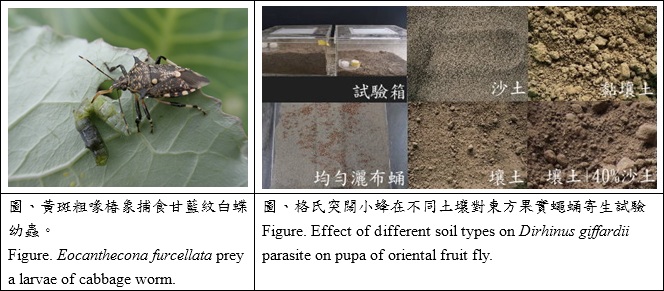- The introduction of biological control
- Establishment of farmer's operational evaluation criteria in the early stage of IPM introduction - taking Miaoli strawberry farmers as an example
- Effects of temperature on parasitism of egg parasitoid wasps, Anastatus japonicus (Hymenoptera: Eupelmidae), using Antheraea pernyi (Lepidoptera: Saturniidae) eggs as alternative host
- The research of intergrated control technology for diseases and pest insects of strawberry in greenhouse
- Application of predator insect on pest control in greenhouse
- Study of storage technology of natural enemies for insect commodity
- Studies on the control for tomato russet mite. 【classified project】
- Development and utilization of mass rearing techniques in natural enemies
- The investigation of biomaterials on preventing crop diseases~ Blumea balsamifera extract
- Application of intergrated control technology for diseases and pest insects in strawberry
- The improvement of propagation techniques on parasitoid and predatory natural enemies
- Studies of anti-stress environment on predator and parasitoid natural enemies insect
- The investigation of biomaterials on preventing crop diseases~ Sapindus mukorossi extract
- The establishment of biocontrol model on diseases and pests in organic tomato【classified project】
- The study of U.S. Department of Agriculture -Pacific Basin Agricultural Research Center(USDA-PBARC)
- Appilication of intergrated control technology for diseases and pest insects in strawberry
- The improvement of propagation techniques on parasitoid and predatory natural enemies
- Studies of anti-stress environment on predatism and parasitism natural enemy insects【classified project】
- The investigation of biomaterials on preventing crop diseases~ Citrus extracts
- The establishment of biocontrol model on diseases and pests in organic tomato
- Application of natural enemies on insect pests of organic vegetables and fruits
- The appilication of intergrated control technology in strawberry disease and pest insects
- The propagation techniques and improvement of Parasitoid and Predatory natural enemies
- The Investigation of Exotic Invading Plants
- Application of natural enemies on insect pests of organic vegetables and fruits
- Application and establishment of integrated management for harmful pests on red jujube
- The investigation of exotic invading plants
- The collection, conservation and setup of gene bank of endemic orchids and fragrant plants in Taiwan
 Home > Recent Research > Biological Control Branch Station > Application of natural enemies on insect pests of organic vegetables and fruits Home > Recent Research > Biological Control Branch Station > Application of natural enemies on insect pests of organic vegetables and fruits
|
Application of natural enemies on insect pests of organic vegetables and fruits
Date:2014-06-17
Cabbage was grown and managed in the net house this year. Population changes of pest and Eocanthecona furcellata (Wolff) were studied. Results showed that diamond-back moth, cabbage worm, and tobacco cutworm harmed cabbage up to 30.5%. Releasing the third instar of Eocanthecona furcellata could lower the damage to 13.2%.
In study of parasitoid, Dirhinus giffardii Silvestri, under different soil type and parasitize on oriental fruit fly pupa, results showed that soil structure and depth will affect the outcome significantly. As soil depth increased, the amount of pupa parasitized number decreased. The parasitized number in the soil types from large to small were clay, loam, loam+40% sand, and sand. There was no difference in clay soil depth on 1, 3, and 5 cm, however, low pupa parasitized number occurred with little parasitoid eclosion under 10 cm depth clay soil because of low water content between clay granular that let Dirhinus giffardii able to search and parasitize the pupa of oriental fly.
In the study of releasing parasitoid on organic orchard in Kungkuan, Miaoli County, with hanging long effectiveness fruit fly trap and checking the number every 10 days. The number of fruit fly trapped from May, June, July, August, September, and October were 88, 84, 26, 16, 63, and 138, respectively. The average number of lacewing trapped per trap was 15 in the same duration. Therefore, totally 105,000 parasitoids were released on July and August around the organic orchard and the road path nearby resulted in persimmon damage by the fruit fly from 4-14%.The observation fruit fly damage rate is still lasting and being record on non-cash plant such as Terminalia, Sapindus, Garcinia suubelliptica, and Ficus microcarpa.


